Hiroshima, Japan
Embark on an unforgettable adventure when you travel to Hiroshima, a city that elegantly juxtaposes a poignant past with a vibrant, forward-looking present. Traveling to Hiroshima, Japan offers a unique experience, as it was forever changed by the events of 1945, yet today exudes an indomitable spirit and unyielding resilience. wander through the Hiroshima Peace Memorial Park, where each exhibit and monument tells a story of human endurance and the unwavering hope for peace. The iconic Atomic Bomb Dome stands as a powerful reminder of the past, but the city's heartbeat lies in its bustling streets, thriving arts scene, and mouth-watering cuisine. Savor the local delicacy, okonomiyaki, a savory pancake laden with seafood, vegetables, and meat, as you mingle with friendly locals who personify the spirit of modern Japan. Stroll along the scenic banks of the Ota River or take a day trip to the sacred island of Miyajima, home to the floating Torii gate of Itsukushima Shrine, a sight that will engrave itself into your memory. The city also offers rich cultural experiences with museums such as the Hiroshima Museum of Art and Shukkeien Garden, an oasis of meticulous landscape and tranquility. Traveling to Hiroshima, Japan isn't just about exploring a destination; it's about engaging with a city that has risen from ashes to become a testament to human resilience and innovation, making it a must-visit location on your next travel itinerary. So, make plans to travel to Hiroshima and be prepared to be captivated by a city that beautifully blends history, culture, and modernity.
The History of Hiroshima, Japan
When you think about a destination rich in historic significance and cultural depth, "Travel to Hiroshima, Japan" should be at the top of your list. Hiroshima's past offers a compelling narrative that attracts visitors from around the globe. Known worldwide for the tragic events of August 6, 1945, when the city became the first to suffer a nuclear attack, Hiroshima has transformed itself into a symbol of peace and resilience. Beyond its somber history, Hiroshima, Japan, is a city that brims with historical landmarks, providing an enriching travel experience for any history enthusiast.
One of the most poignant places to visit when you travel to Hiroshima is the Hiroshima Peace Memorial Park. This site isn't just a place for contemplation and remembrance—it’s a powerful testament to the city's remarkable recovery and dedication to peace. The park houses several important landmarks, including the A-Bomb Dome, the Peace Memorial Museum, and the Children's Peace Monument. Each of these spots offers a unique insight into the events of that fateful day and the subsequent efforts to promote global peace and reconciliation. Traveling to this park will undoubtedly leave you with a deeper understanding of the resilience of the human spirit.
Another significant historical attraction is the Hiroshima Castle, originally constructed in the 1590s. Though the original structure was destroyed in the atomic bombing, the castle was meticulously rebuilt in 1958. Now a museum, Hiroshima Castle offers visitors a journey back to the feudal era of Japan, providing context about the region's samurai culture and local history before the modern era. The castle's architecture and grounds are perfect for those interested in historical landmarks and Japanese heritage, making it an essential stop when you travel to Hiroshima, Japan.
No trip to Hiroshima, Japan, would be complete without a visit to Itsukushima Shrine on Miyajima Island, often referred to as "The Floating Shrine." This UNESCO World Heritage Site is famous for its torii gate, which appears to float on the water during high tide. The shrine's history dates back to the 6th century, offering an impressive insight into ancient Shinto beliefs and practices. The island itself is a haven for those wanting to explore tranquil temples, admire breathtaking views, and experience local cuisine. Whether you're a history buff or a traveler looking for a serene escape, Miyajima Island is an integral part of any travel to Hiroshima itinerary.
So, if you’re planning your next travel adventure and are looking for a destination that combines poignant history with rich cultural experiences, travel to Hiroshima, Japan. The city not only tells a profound story of tragedy and resilience but also offers a multitude of attractions that will leave you both informed and inspired. From peaceful memorials and ancient castles to sacred shrines, Hiroshima, Japan, welcomes you to explore its storied past and vibrant present.
The Culture of Hiroshima, Japan
When you travel to Hiroshima, Japan, you will discover a city rich in culture, history, and resilience. This dynamic city, marked by its tragic past, has risen from the ashes to become a beautiful symbol of peace and reconstruction. The people of Hiroshima are deeply connected to their roots and have a profound commitment to peace, making it a unique destination for those seeking a meaningful travel experience. Whether you're strolling through its serene parks, exploring its historical sites, or participating in traditional festivals, Hiroshima offers a distinctive cultural journey that cannot be found anywhere else.
The Spirit of Resilience and Peace
The culture of Hiroshima is steeped in the values of peace and resilience. After the atomic bombing in 1945, the city was determined to rebuild and become a beacon of hope for the world. Today, when you travel to Hiroshima, you'll find numerous memorials and museums dedicated to promoting global peace. The Hiroshima Peace Memorial Park and Museum are key attractions where visitors can learn about the history and impact of the bomb, as well as the ongoing efforts for nuclear disarmament. This profound commitment to peace is a cornerstone of the culture in Hiroshima, making it a poignant destination for travelers.
Rich History and Traditions
The historical significance of Hiroshima, Japan extends beyond the events of World War II. The city boasts a rich cultural heritage that dates back centuries. Travel to Hiroshima, Japan, and you will come across architectural marvels like Hiroshima Castle and Shukkeien Garden, which offer glimpses into the city's feudal past. These historical sites are not only visually stunning but also serve as reminders of the city's enduring spirit and craftsmanship. Additionally, traditional Japanese tea ceremonies, sumo wrestling, and local artisan crafts keep the ancient traditions alive, offering travelers an authentic taste of Japanese culture.
Fascinating Local Cuisine
Hiroshima is also known for its delectable local cuisine, which is sure to be a highlight of your travel to Hiroshima experience. The city's signature dish, Hiroshima-style okonomiyaki, is a must-try. Unlike the version found in other parts of Japan, Hiroshima’s take on this savory pancake includes layers of ingredients cooked to perfection. Another local favorite is fresh oysters, harvested from the nearby Seto Inland Sea, enjoyed barbecued, fried, or raw. Exploring Hiroshima’s food scene provides not only a culinary delight but also an insight into the city’s way of life and its connection to the local landscape.
Vibrant Festivals and Community Events
When you travel to Hiroshima, Japan, be sure to experience its vibrant festivals and community events that reflect the city’s enduring spirit and unity. The Hiroshima Flower Festival, held every May, transforms the city into a colorful spectacle of floral arrangements, lively parades, and local performances. This festival celebrates the city's rejuvenation and the arrival of spring with a message of peace and hope. Additionally, the T?r? Nagashi event during the Bon Festival, where thousands of paper lanterns are floated down rivers to honor the deceased, provides a deeply moving and culturally enriching experience. These events allow travelers to immerse themselves in the communal spirit and cultural identity of Hiroshima.
The Food of Hiroshima, Japan
Travel to Hiroshima, Japan, and immerse yourself in a culinary journey that tantalizes the taste buds and unveils the heart of Japanese culture. Known for far more than its historical significance, Hiroshima demonstrates an exceptional prowess in the culinary arts, offering numerous unique dishes that stand out within Japan's rich and diverse gastronomy. Whether you are a foodie on a quest for new flavors or simply a traveler seeking to explore local traditions, Hiroshima's culinary scene will not disappoint.
Iconic Hiroshima Okonomiyaki
One cannot talk about the culinary experience in Hiroshima without highlighting Okonomiyaki, a savory Japanese pancake that has become synonymous with the city. Unlike the Kansai (Osaka) style, Hiroshima-style Okonomiyaki is layered rather than mixed, including ingredients such as cabbage, pork belly, seafood, and yakisoba or udon noodles. Each layer is cooked to perfection on a teppan (iron griddle), resulting in a dish that is as visually appealing as it is delicious. Travel to Hiroshima and find yourself seated in the authentic Okonomiyaki-ya (specialty Okonomiyaki shops) where chefs expertly craft these culinary masterpieces right before your eyes.
Delectable Hiroshima Oysters
Seafood lovers should prepare to indulge in Hiroshima's famous oysters. These plump and juicy delicacies are farmed in the pristine waters of the Seto Inland Sea, making Hiroshima the leading oyster producer in Japan. Whether enjoyed raw with a touch of lemon, grilled to smoky perfection, or fried in a light and crispy batter known as Kaki Furai, Hiroshima oysters provide a burst of oceanic flavor that is second to none. Travel to Hiroshima, Japan, during the annual Oyster Festival, and you will encounter an unforgettable atmosphere of culinary celebration, with countless stalls offering creative oyster-based dishes.
Hiroshima Ramen and Tsukemen
Beyond the coastal delights, travelers to Hiroshima, Japan can savor local variations of ramen and tsukemen (dipping noodles). Hiroshima ramen typically features a soy sauce-based broth, characterized by its robust and savory flavor, complemented by toppings like slices of chashu pork, green onions, and bamboo shoots. Meanwhile, Hiroshima tsukemen offers an interactive dining experience, with hot dipping broth served alongside cold noodles, allowing you to enjoy each bite with its optimal texture and temperature. This local twist on traditional Japanese noodles ensures a unique experience for noodle enthusiasts traveling to Hiroshima.
Exquisite Hiroshima Sake
No culinary exploration of Hiroshima would be complete without sampling its renowned sake. Hiroshima is one of Japan's most famous sake-producing regions, thanks to its pure spring water and high-quality rice. Travel to Hiroshima and discover sake breweries that date back centuries, offering tasting tours where you can learn about the meticulous brewing process and sample various types of sake, each with distinct flavor profiles ranging from sweet and fruity to dry and crisp. Pair your chosen sake with local dishes for a heightened gastronomic experience that reflects the harmony of flavors Hiroshima, Japan, has to offer.
From indulgent street food to upscale dining experiences, Hiroshima, Japan, presents a culinary landscape that is as diverse as it is delicious. Whether you are tasting the iconic Hiroshima-style Okonomiyaki, savoring the freshest seafood, slurping hearty bowls of ramen, or sipping on exquisite local sake, every meal in Hiroshima becomes a memorable part of your travel story. So, pack your appetite and travel to Hiroshima for an unforgettable culinary adventure.
What to See and Do in Hiroshima, Japan
Are you planning to travel to Hiroshima? This vibrant city in Hiroshima, Japan, offers a wealth of experiences that combine cultural richness, historical significance, and natural beauty. Dive into this detailed guide of must-see attractions and activities that will make your travel to Hiroshima an unforgettable adventure.
Explore the Hiroshima Peace Memorial Park
A trip to Hiroshima, Japan would be incomplete without visiting the Hiroshima Peace Memorial Park. Located in the heart of the city, this poignant park is dedicated to the victims of the atomic bombing in 1945. The park is home to several important monuments, including the iconic A-Bomb Dome, which remarkably withstood the blast. Take your time wandering through the park, paying respects at the Cenotaph for the A-bomb victims, and visiting the Peace Memorial Museum to gain a deeper understanding of the tragic events and the city's resilient recovery.
Visit Hiroshima Castle
Hiroshima Castle, also known as Carp Castle, is a beautiful reconstruction of the original 16th-century structure that was destroyed during World War II. Nestled amidst lush greenery in Hiroshima, Japan, the castle features a moat and a five-story main keep. The interior now serves as a museum that offers detailed exhibits on samurai culture and the history of Hiroshima. Climb to the top floor to enjoy panoramic views of the city and its picturesque surroundings.
Take a Trip to Miyajima Island
No travel to Hiroshima is complete without a visit to Miyajima Island, known for the iconic Itsukushima Shrine and its “floating” torii gate. Located just a short ferry ride from the mainland, this island is a wonderful escape into nature. Enjoy walking through the centuries-old streets, visiting the towering Five-Tiered Pagoda, and hiking up Mount Misen for breathtaking views. Don’t forget to sample the famous local delicacies, including freshly grilled oysters and Momiji Manju, a maple-leaf-shaped cake stuffed with sweet fillings.
Experience Shukkeien Garden
Shukkeien Garden is a stunningly landscaped Japanese garden in Hiroshima, Japan. Originally constructed in 1620, the garden features miniaturized landscapes, reflecting ponds, and teahouses perfect for traditional tea ceremonies. Walk along the tranquil paths to see beautifully manicured trees, seasonal flowers, and charming bridges. This garden is a peaceful retreat within the bustling city, offering visitors a chance to relax and appreciate Japanese horticultural artistry.
Indulge in Hiroshima Okonomiyaki
When you travel to Hiroshima, tasting the local cuisine is a must, and Hiroshima Okonomiyaki is a culinary highlight. This savory pancake, layered with vegetables, meat, seafood, and topped with a delicious sauce, is cooked right in front of you on a hot griddle. Visit Okonomimura, a building dedicated to Okonomiyaki containing multiple floors of competitive vendors, to try this hearty dish and immerse yourself in the local food culture.
Ride the Hiroshima Electric Railway (Hiroden)
The Hiroshima Electric Railway, or Hiroden, offers a nostalgic and convenient way to explore the city. These charming streetcars are an essential part of Hiroshima's public transport system and provide an enjoyable means to navigate between major attractions. The Hiroden system not only boasts historical significance but also treats riders to the viewing of scenic streetscapes and a genuine taste of local daily life in Hiroshima, Japan.
Visit the Hiroshima City Museum of Contemporary Art
Art enthusiasts traveling to Hiroshima should not miss the Hiroshima City Museum of Contemporary Art. This museum, set in a beautiful park on Hijiyama Hill, showcases a wide range of contemporary art from both Japanese and international artists. The museum also hosts special exhibitions, workshops, and educational programs, making it a dynamic venue for appreciating modern artistic expressions against the backdrop of Hiroshima, Japan.
Attend a Hiroshima Carp Baseball Game
Join the locals in cheering for the Hiroshima Toyo Carp, the city's beloved professional baseball team. Attending a Carp game at the Mazda Zoom-Zoom Stadium Hiroshima is an exhilarating experience. The enthusiastic atmosphere, complete with chanting fans clad in red, unique stadium food, and the thrill of the game, offers a fun and culturally immersive activity for sports fans traveling to Hiroshima, Japan.
Explore Hondori Shopping Arcade
Hondori Shopping Arcade is a bustling pedestrian street in downtown Hiroshima, Japan. Lined with a variety of shops, cafes, and restaurants, this covered shopping area offers a vibrant mix of traditional and modern goods. Stroll through the arcade to shop for souvenirs, sample local street food, and soak in the lively atmosphere. The arcade is also conveniently located near the A-Bomb Dome and Peace Memorial Park, making it a perfect spot for a leisure break during your explorations.
Discover Mitaki-dera Temple
For a serene escape, visit Mitaki-dera Temple, a hidden gem nestled in the forested mountainside of Hiroshima, Japan. This ancient temple complex dates back to 809 AD and is surrounded by lush greenery, waterfalls, and tranquil walking paths. The temple is especially beautiful during the autumn when the foliage transforms into brilliant shades of red and yellow. It's a perfect spot for those seeking spiritual reflection and natural beauty away from the city’s hustle and bustle.
Whether you're a history buff, an art lover, a foodie, or someone who simply wants to soak in natural beauty, travel to Hiroshima, Japan offers diverse and enriching experiences. Each of these activities provides a unique glimpse into the cultural and historical tapestry of this remarkable city.
Why You Should Travel to Hiroshima, Japan
Hiroshima, Japan, is a captivating travel destination that beckons travelers from around the globe with its rich history, breathtaking landscapes, and vibrant culture. When you travel to Hiroshima, you are immediately immersed in a city that has reinvented itself from its tragic past to become a symbol of peace and resilience. The Hiroshima Peace Memorial Park serves as a poignant reminder of the events of August 6, 1945, with its museums and monuments offering profound insights into the effects of the atomic bomb. This historical significance is one of the primary reasons why travelers love to explore Hiroshima, as it provides an opportunity to reflect on the past while appreciating the efforts made towards global peace.
An equally compelling reason to travel to Hiroshima is its stunning natural beauty and outdoor attractions. Nestled in the Chugoku region of Japan, Hiroshima is surrounded by lush mountains and pristine waters. The Seto Inland Sea offers travelers endless opportunities for scenic boat rides, island hopping, and enjoying the serene beauty of places like Miyajima Island. Known for its iconic Torii Gate that appears to float on water during high tide, Miyajima Island is a must-visit spot for anyone traveling to Hiroshima, Japan. The island also features the historic Itsukushima Shrine, beautiful hiking trails, and friendly deer roaming freely, creating an idyllic setting. These natural attractions make Hiroshima a haven for nature lovers and adventure seekers alike.
Cultural enthusiasts will find Hiroshima, Japan, a treasure trove of experiences. The city's vibrant arts scene, traditional festivals, and culinary delights offer an authentic taste of Japanese culture. Local delicacies such as Okonomiyaki, a savory pancake filled with various ingredients, and fresh oysters are culinary highlights that no traveler should miss. Additionally, Hiroshima hosts several annual festivals like the Flower Festival in May and the Hiroshima Dreamination in winter, filling the city with colorful displays, parades, and performances. The combination of historical depth, natural splendor, and cultural richness makes travel to Hiroshima a fulfilling and unforgettable experience.
Why You Must Travel to Hiroshima
You must travel to Hiroshima, Japan, to witness firsthand the remarkable journey of a city that rose from the ashes to become a beacon of peace and cultural vibrancy. By traveling to Hiroshima, you not only explore a destination rich in history and beauty but also join a global community that honors resilience, peace, and the human spirit. From the somber yet inspiring Hiroshima Peace Memorial Park to the natural wonders of Miyajima Island and the authentic cultural experiences, Hiroshima offers a unique blend of reflection and adventure that every traveler should experience at least once in their lifetime. Don't miss the chance to travel to Hiroshima and create memories that will stay with you forever.
Tips & Tricks for Traveling in Hiroshima, Japan
Travel to Hiroshima offers an enriching experience filled with historical landmarks, delectable cuisine, and stunning natural vistas. To make the most of your journey to Hiroshima, Japan, dive into these ten essential tips and tricks, designed to ensure a seamless and unforgettable trip.
1. Purchase a Japan Rail Pass
One of the best ways to navigate Hiroshima, Japan is by utilizing the Japan Rail Pass. This pass offers unlimited travel on JR trains, buses, and ferries, making it easy to visit popular attractions such as the Hiroshima Peace Memorial Park and Miyajima Island. The pass also provides flexibility, allowing you to explore surrounding regions without the hassle of purchasing individual tickets.
2. Stay Near Hiroshima Station
When planning your travel to Hiroshima, consider booking accommodations near Hiroshima Station. Staying close to this transport hub offers ease of access to various parts of the city and beyond. Hotels in this area also come with the added advantage of nearby dining options, convenience stores, and tourist information centers, making your stay more comfortable.
3. Download a Translation App
Although many people in Hiroshima, Japan speak some English, it's beneficial to have a translation app handy. This will help you navigate menus, ask for directions, and enhance communication with locals. Apps like Google Translate even offer a camera feature that translates text in real-time, which can be invaluable during your travels.
4. Visit Hiroshima Peace Memorial Park Early
To fully appreciate the historical significance of Hiroshima, Japan, make an early morning visit to the Hiroshima Peace Memorial Park. Arriving early allows you to explore the park's monuments, museums, and the Atomic Bomb Dome before the crowds arrive. This serene time of day also enhances the reflective atmosphere of this solemn site.
5. Try Hiroshima-style Okonomiyaki
Food enthusiasts travel to Hiroshima specifically to taste the famous Hiroshima-style okonomiyaki, a savory pancake layered with ingredients like cabbage, pork, seafood, and noodles. Head to Okonomimura, a multi-floor building with numerous stalls serving this iconic dish. Each vendor adds their unique twist, promising a culinary adventure in every bite.
6. Take a Day Trip to Miyajima Island
No travel to Hiroshima, Japan is complete without a day trip to Miyajima Island. Known for its floating torii gate and the sacred deer that roam freely, Miyajima offers a mix of natural beauty and cultural heritage. To make the most of your visit, try to catch the ferry during low tide, which lets you walk up to the iconic gate.
7. Use a Suica or Pasmo Card
For convenient travel within Hiroshima, invest in a Suica or Pasmo card. These rechargeable smart cards can be used on buses, trams, and trains throughout Hiroshima, Japan. They save you the trouble of buying small change and individual tickets, providing an effortless way to navigate the city.
8. Explore Hiroshima’s Hidden Gems
While the main attractions are must-sees, don’t miss out on Hiroshima’s hidden gems. Places like Shukkeien Garden offer a peaceful retreat with beautifully landscaped grounds. Likewise, the Hiroshima Orizuru Tower provides a unique observation deck experience, with panoramic views and interactive exhibits that highlight the city's rebuilding efforts.
9. Learn Basic Japanese Phrases
Although a translation app is helpful, learning a few basic Japanese phrases can go a long way in enhancing your travel to Hiroshima, Japan. Greetings like “Konnichiwa” (Hello), “Arigatou” (Thank you), and “Sumimasen” (Excuse me) are simple yet effective in showing respect and making connections with locals.
10. Respect Cultural Etiquette
Respecting local customs is crucial when you travel to Hiroshima. Always remove your shoes before entering temples and traditional accommodations, and maintain a low noise level in public spaces out of consideration for others. Furthermore, understanding and following social norms not only enriches your experience but also leaves a positive impression on the local community.
Following these tips will undoubtedly enhance your journey to Hiroshima, Japan, providing a richer, more immersive experience. Whether you're delving into the city's poignant history, savoring its unique cuisine, or exploring its natural wonders, your travel to Hiroshima promises to be a memorable adventure.
Other Places You Might Like
Kyoto, Japan - If you are planning to travel to Hiroshima, Japan, you should definitely consider adding Kyoto to your itinerary. Kyoto offers a deep dive into Japan's historical and cultural roots with its numerous temples, gardens, and traditional wooden houses. The iconic Fushimi Inari Shrine, with its thousands of vermillion torii gates, and the serene Kinkaku-ji (Golden Pavilion), provide a stark contrast to the modernity of Hiroshima’s Peace Memorial Park. Kyoto’s Arashiyama Bamboo Grove is a natural wonder that offers a meditative walk through towering bamboo, making it a must-see for anyone enchanted with Hiroshima, Japan.
Miyajima, Japan - Nestled close to Hiroshima, Miyajima is famous for the Itsukushima Shrine and its iconic floating torii gate. The serene beauty of this island complements a trip to Hiroshima. Nature trails, wild deer, and scenic views from Mount Misen enhance its allure. Visitors can enjoy the peaceful island ambiance while taking in the historical richness that both Miyajima and Hiroshima offer.
Nagasaki, Japan - Those who travel to Hiroshima, Japan, often find Nagasaki just as compelling. Like Hiroshima, Nagasaki endured the tragedy of an atomic bombing. The Nagasaki Peace Park and Atomic Bomb Museum offer a somber yet enlightening experience. The city’s juxtaposition of Western and Japanese cultures is evident in places like Dejima and Glover Garden, making it a fascinating destination for those interested in history and international culture.
Osaka, Japan - Osaka provides a vibrant city experience that's perfect for travelers who enjoy Hiroshima, Japan. This bustling metropolis offers a lively nightlife, exceptional street food, and sightseeing locations like Osaka Castle and the futuristic Umeda Sky Building. Dotonbori, with its neon lights and eclectic dining options, contrasts beautifully with the reflective atmosphere of Hiroshima’s Peace Memorial Park, offering a well-rounded travel experience.
Nara, Japan - Just a short distance from Kyoto, Nara is another destination that history lovers will appreciate when they travel to Hiroshima, Japan. Nara Park, home to hundreds of friendly deer and the monumental Todai-ji Temple with its massive Great Buddha statue, provides a tranquil experience filled with natural and historical wonders. Furthermore, Nara’s ancient temples and serene landscapes offer a reflective escape much like the peaceful corners of Hiroshima.
Himeji, Japan - Himeji is home to Japan's most spectacular castle, Himeji Castle, which is a UNESCO World Heritage site. Travelers fascinated by Hiroshima’s history will enjoy the architectural splendor and historical significance of this landmark. The well-preserved castle offers insight into Japan’s feudal past and compares well with Hiroshima’s modern historical sites.
Kamakura, Japan - For those intrigued by the historical depth they find when they travel to Hiroshima, Japan, Kamakura is another captivating destination. Known for its giant Great Buddha (Daibutsu) and numerous old temples such as Tsurugaoka Hachimangu and Hase-dera, Kamakura offers a taste of medieval Japan. The coastal city’s hiking trails, like those in the surrounding areas of Hiroshima, provide stunning natural scenery and a spiritual retreat.
Takayama, Japan - Takayama’s beautifully preserved old town and traditional festivals offer a slice of Japan's history and culture. If you adored the peace and reflective ambiance of travel to Hiroshima, Japan, you would find Takayama’s Edo-period streets and rural charm enchanting. The nearby Shirakawa-go, a UNESCO World Heritage site with thatched-roof farmhouses, enhances the historical experience.
Kanazawa, Japan - Similar to Hiroshima, Japan, Kanazawa combines history with a blend of modernity. The city boasts one of Japan’s most beautiful gardens, Kenroku-en, and the well-preserved samurai and geisha districts. The 21st Century Museum of Contemporary Art provides a modern counterpoint to the historical attractions, making Kanazawa a destination rich in cultural and artistic diversity.
Hakone, Japan - Hakone’s natural beauty and hot springs make it an ideal destination for relaxation after the reflective experience of travel to Hiroshima, Japan. The breathtaking views of Mount Fuji, the Hakone Open-Air Museum, and the historic Hakone Shrine present a tranquil yet exciting escape. A cruise on Lake Ashi offers picturesque scenery that complements the entire travel experience.
Japan Megaquake Advisory Lifted After M7.5 Quake
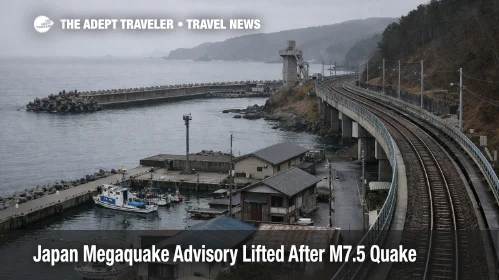
JR East Winter Stop Skips On Senzan And Ou Lines
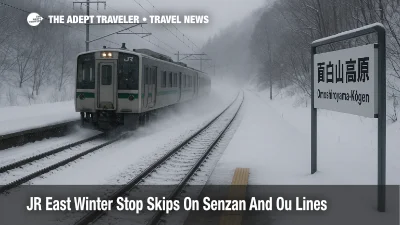
Japan Megaquake Advisory Hits Tohoku Winter Travel

Park Hyatt Tokyo Reopening December 2025 Rooms Update

India Advisory On China Airport Transit After Detention

Japan Megaquake Advisory Puts Northern Travel On Watch

Weather Delays Across Japan Hit Key Airports December 8

Asia Pacific Design Hotel Openings Through 2025

2028 World Cruise From Miami To Athens With Azamara
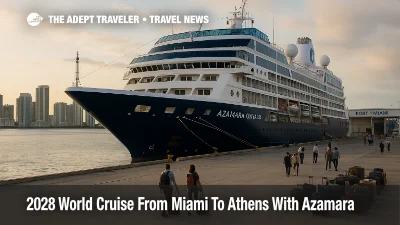
Japan Domestic Flight Disruptions Hit Key Hubs November 30
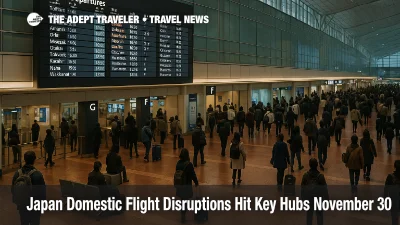
China Japan Flight Cuts Hit December 2025 Travel

Festive Tiffany Afternoon Tea At Waldorf Astoria Osaka

China Japan Flight Cuts Disrupt December Trips

Shanghai Layover Rules Put Arunachal Travelers At Risk
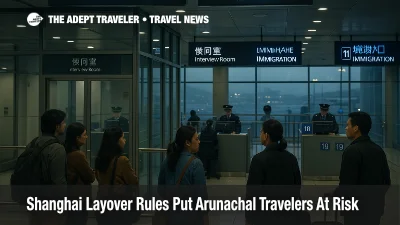
China Japan Flight Cuts Hit December Trips

China Japan Travel Warning Cuts Flights And Tourism

Japan Free Domestic Flights For Europe Arrivals

China Japan Flight Cancellations Spike November 27

REI Teams With Intrepid For Member Adventure Trips

U.S. Issues Japan Bear Attack Travel Warning
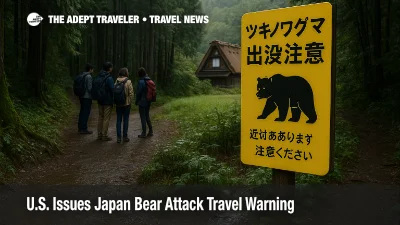
China Japan Travel Spat Deepens, Mass Flight Cancellations

China Japan Tensions Hit Travel And Tourism

China Japan Travel Spat Cancels 491k Tickets

G Adventures Black FriYAY Sale Up To 30% Off

Global Guardian Flags Geopolitics as Top Travel Risk

